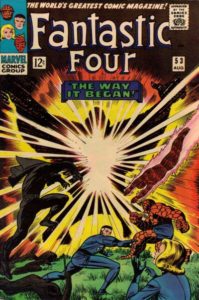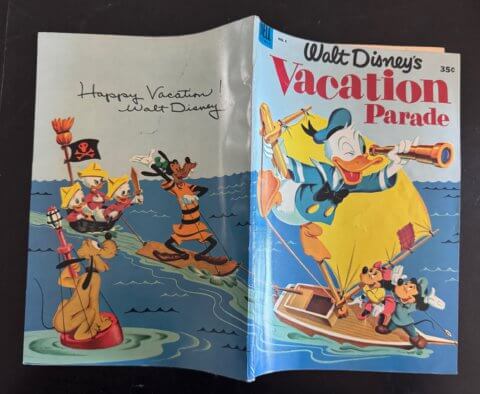
Like I mentioned in the first post of this column, I’m planning to cover a lot of topics with some being meaty and others a little lighter but still worth discussing. I’m not sure where the Origin Issue falls but I’ve always been drawn to these issues.
Is it just me or are the old classic origin issues not what they used to be on the back issue market? I’ve often added in “Origin Issue” as an important factor in some Undervalued Spotlight book I’ve argued for but looking around I’m not seeing the same reverence given these issues today when compared to the reverence given to them by past generations of collectors.
My favourite example is Fantastic Four #53 featuring the Origin of the Black Panther. I jumped on the GPA site to analyze prices and tried to stick to grades with recent sales, a CGC 8.0 Fantastic Four (FF) #53 fetched $181 in December 2019 while that same grade could have been bought for $105 back in 2012. I compared these results against copies of Fantastic Four #52 which features the first appearance of the Black Panther. A CGC 8.0 FF #52 recently (February 2020) sold for $2,200 while the same grade could have been snagged for a measly $275 back in 2012. This data tells us that an FF #52 has shot up 800% these past eight years while an FF #53 has inched up 72% over the same period. Obviously the first appearance issue has grossly outperformed the origin issue.

Remember Superman #53? Superman #53 with its classic Superman origin cover has always been lauded as the first detailed origin of Superman. Superman’s first brief origin was of course in Action Comics #1 then there were an added two pages in Superman #1 and finally on the third telling in Superman #53, we got a more detailed origin. Anybody collecting in the 80s and 90s can attest that this book was seen as a heavyweight. I checked the lower grades (because those were the graded I could get comparables to Superman #1) and found that copies of Superman #53 have roughly doubled in value over the last ten years, contrast that to low-grade copies of Superman #1 which have seen seven-fold increases over the last ten years in the CGC 1.0 grade. Obviously expanded origins can’t compete with first issues either.

Data mining is tricky and easy to manipulate to help prove my point so I won’t argue that these examples above are true across the board but I get a sense that they are. The only book I can think of that bucks this trend is Detective Comics #33 containing the origin of Batman. GPA data supports it keeping up with its peers but I always had the feeling it was usurped as a darling by the likes of Detective Comics #31 and Detective Comics #35 (both cover driven issues).
Am I right about the origin issues losing its shine? Would Detective Comics #27 be worth even more if it was like Action Comics #1 or Amazing Fantasy #15 and could boast Origin and first appearance of Batman?
I’ll still argue for origin issues, I think they deserve better, how many Spidey movies have we had? How many of them retold the origin? Origins are important to comic books, movies and popular culture in general, what has happened?




I think that your general premise is completely correct, but the first book that came to mind was Wonder Woman #98. A 6.5 sold in 2012 for $220 and in 2019 for $4900. So not all origins are alike. (Also Batman #47 is hanging in there.)
I don’t think that there is anything very deep to this – “first appearance” is now _the_ key. The only controversy about this is what is a “true” first appearance. (I have a Web of Spider-Man #18, so I would appreciate it if non-appearance first appearances were to be agreed to be “true” first appearances.)
Origins are just backstory, and everybody now knows this can be changed, so none of the tellings is viewed as definitive. So I think it could be argued that origin issues should even take a backseat to crucial events. Character deaths would be the first candidate for these events, but as everybody seems to come back from the dead, these have not held up well. Currently I like your Undervalued picks of FF #28 and X-Men #9 for these kinds of events – not first appearances, but first meetings. These are good because the details don’t really matter, you just the cover as evidence.
I think another part of the picture is fashion and scarcity. The origin question is along the lines of the first issue question. In the nineties it was all about first issues, hence the publishers pumped these out for the stockpilers. Collectors had always prized first issues, and for the most part these were retained and cared for better than other issues in a title. The fallout from the nineties glut probably worked against this fashion, and collectors maybe woke up to the fact that first appearances were relatively scarcer, given that there was no “#1!” on the cover to attract otherwise ignorant buyers. Similarly for decades the origin issues (viewed as much more definitive in the good ol’ days, as publishers stuck strongly to the existing continuity) had been prized and held with more care. The combined factors of mutable continuity (e.g. Crisis on Infinite Earths) and relative availability chipped away at the desirability of these issues. Once collectors start thinking “everybody collects #1s” or “everybody collects origins”, they start looking for something else.
Of course another problem is slabbing. We have to take the word of CGC on the slab about “origin retold” – we can’t read it. Again this argues for other types of key events that are depicted on covers.
I think that there is a somewhat hopeful sign in this. If the market were purely hardcore comic geeks, origin issues and even more obscure books would perform better on a _relative_ basis because of their import in the history of the character/title/comics. (Unfortunately for me, Detective #327 is a book like this that comes to mind.) I think that the outperformance of first appearances indicates that there is demand well beyond this hardcore community, and this rising tide lifts all boats, so the _absolute_ performance of these obscure books is improved. Yes it would have been better to have an FF #52 than an FF #53, but if FF #52 had not done so well, FF #53 would certainly not be up the 72% that you mention.
Well…I agree with you both! Origins and first appearances have both suffered from the 90’s glut. Certain characters transcend that but it doesn’t mean they haven’t been affected as well. The mentioned FF issue is a great example! By the time FF 53 hit the stands the origin didn’t matter anymore! We had a new exciting character on the ground running and where he came from was, as Chris clearly states, backstory. That is not to say it wasn’t needed at some point… it wasn’t as important as first reveal! I get you Walt…I like a good origin story too… but as Chris also points out it can be changed over time… that turnover in generations of readers may not be as quick as it was in my day or before…so the origin of any give character can be changed by the next up and coming writer. While not an origin remember when we all thought several years of Spiderman lore were done by a clone? While classic issues of origins may be undervalued… it doesn’t mean they aren’t valued at all!
You are right Chris there were phases over the years, it seemed like the Silver Age was big on Origins, Tales of Suspense #63 was a big book back when I started out.
I agree with a lot of what Chris is saying as well Gerald, I’m just trying shed light on the fact that these things were once much more revered.
For me the most interesting thing is… I have noticed I am now scrutinizing comics I am interested in to a much greater extent then I ever have before. I figure anything I collect at this point in my life it better have a little reward to it…as I may not have it that many more years!